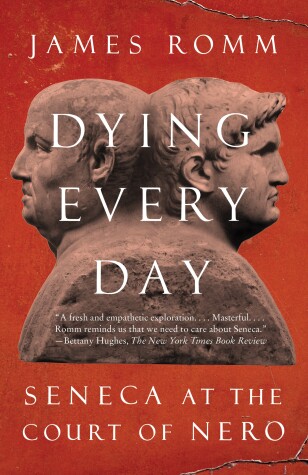Reviewed by viking2917 on
James Romm's "Dying Every Day" is an accessible and intriguing biography of Seneca, the man behind the throne during the reign of Nero. Seneca is a study in contradictions: a Stoic philosopher, author of any number of letters, philosophical tracts and plays extolling the virtues of a simple, virtuous life, he was at the same time Nero's "consigliere", complicit in any number of foul deeds and deeply entrenched in the corrupt court of Nero. Intrigue, Poison and outright murder of political rivals was common. He was also present in the courts of Caligula and Claudius. The parallels to Thomas Cromwell as portrayed in Hilary Mantel's "Wolf Hall" are striking.
I found the book deeply interesting and educational, and an easy read for a history book. The title comes from one of Seneca's letters, "Consolation to Marcia", in which he expounds the Stoic philosophy that to be born is to begin dying, and that death is always with us. "We are all of us dying every day". But equally well might this apply to Seneca's slow spiritual death, essentially trapped in his role as Nero's right hand.
For years Seneca served first as Nero's tutor during his early years, then as his primary counselor once Nero became emperor. There's a great Greek word for this, from the book - Seneca was called a tyrannodidaskalos - "tyrant-teacher".
I learned any number odd facts from the book. Seneca's brother Gallio was proconsul of a territory in Greece where the apostle Paul was preaching, and after a disturbance Paul was brought before Gallio (who like Pilate "washed his hands" of the matter). (Paul was a Roman citizen by the way). Eventually Paul invoked his right as a citizen to an appeal before the emperor and was shipped to Rome. While there's no documentation of a meeting it's entirely likely Paul met the emperor, and there is evidence (somewhat sketchy) that Paul became friends with Seneca.
Seneca also became fabulously wealthy during his life (likely through questionable use of his office), and lent a great deal of money to tribal leaders in Roman Britain. The uprising of the tribes led by the woman warrior Boudicca can be traced to Seneca calling in his loans.
The book chronicles the twists and turns of life at court - the intrigues, the murders, and the shifting alliances that allowed one to stay alive when a wrong word would get you killed by the emperor or a rival. Along side that it covers Seneca's writings and how they influence or were influenced by events. The book is well worth the read, but in the end I wasn't entirely satisfied. Much of the book seems speculation (phrases like "he must have..." or "likely" crop up a lot) and I don't feel I really got to the heart of the contradiction in Seneca's character - but the historical facts are so spare, perhaps that has to wait for a work of fiction. There's great material for a historical fiction novel in there....
Reading updates
- Started reading
- 30 May, 2015: Finished reading
- 30 May, 2015: Reviewed
